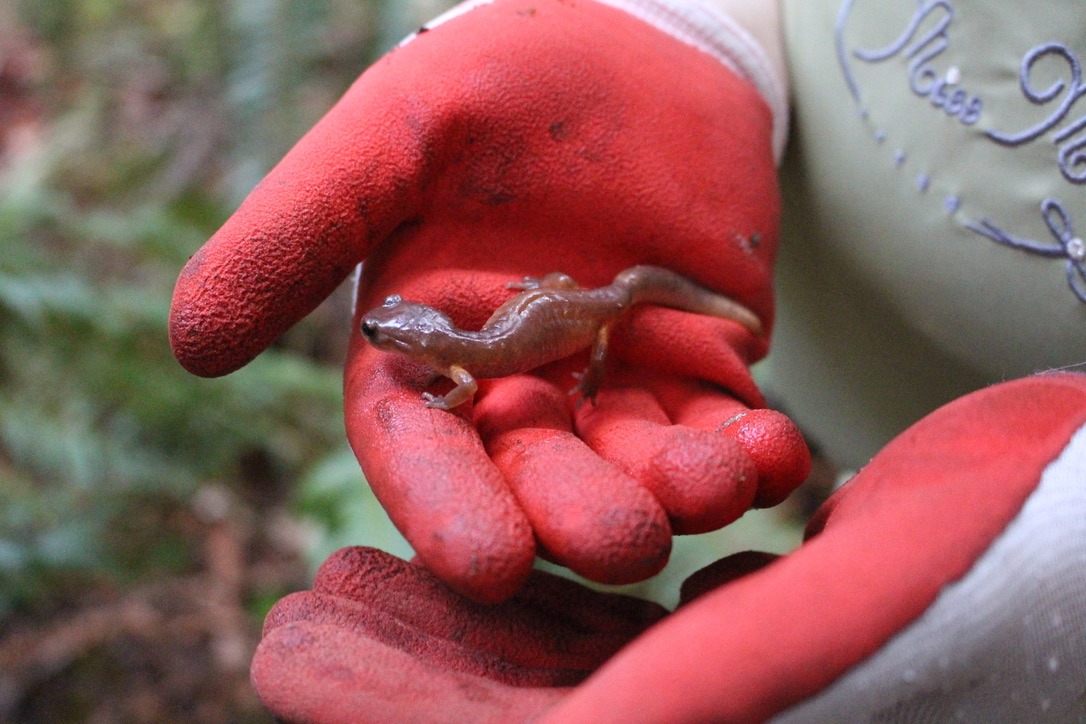healing can be messy
On an early spring morning, I found myself in a peculiar position: on my hands and knees, wedged in damp dirt and gingerly picking up rotting logs.
Despite what you may think, this isn’t how I usually spend my Saturdays. However, I was on a mission with fellow volunteer citizen scientists to survey the area for salamanders – a sign that a sliver of the forest was healing after a recent attempt to address decades of degradation.
A year ago, Camp Creek looked like a chaotic construction zone. Workers donned orange vests and hard hats as they hauled in hundreds of large logs, scattering them at disordered angles by hand and machinery. Pleading spines groaned and engines roared, seemingly unfazed by the lack of a clean and orderly operation.
But this wasn’t the harbinger of the environment’s breakdown – it was a solution. Restoration looks as messy as nature itself sometimes.
The Camp Creek-Cispus River subwatershed is one of eight subwatersheds that make up the Lower Cispus River watershed in the Gifford Pinchot National Forest. A multitude of tributaries here course through rolling forests of old-growth Douglas firs, alder, cedar, hemlock and maple. Watery tendrils reach out for miles to eventually bump elbows with the Cowlitz River, a major arm of the lower Columbia River. Networking between tributaries and the river is critical for native fish runs, which weave across the system until they can eventually spawn and die.
Camp Creek is among many streams in this subwatershed that is home to a menagerie of aquatic life, from puny macroinvertebrates and salamanders to busty beavers and eagles. Notably, wild populations of spawning Chinook, coho, steelhead and cutthroat trout once filled Camp Creek – all of which are now federally listed as threatened or endangered.
The cause(s) of these listings are linked to a mixed bag of human activity, whether direct or indirect. Operations like salvage logging, diking and road building stained the ecosystem’s natural processes.
Timber sales removed large trees that would otherwise fall into waterways, creating pockets of cold water for salmon to rest. Roads and bridges were needed to transport this timber, which meant that the streams’ journeys had to change so they didn’t slow down a booming industry. Installed barriers told water to flow in simple lines, thus resulting in streams cutting deeper into the earth rather than freely meandering across floodplains. As a result, side channels, oxbows and wetlands dwindled, as did the ability for aquatic life to navigate their habitat.
Luckily, mending the ecosystem’s fragmented state can be simple, and it starts with allowing water to flow freely. At least the way it did before settlers arrived.
Installing natural structures like wood jams (think, fallen trees) and beaver dams mimics stream processes that were plentiful before human influence. Heavy rainfall and snowmelt – both channel-forming high flow events – flood a forest floor, and these structures can block and redirect flows to promote an incised stream to spread outwards. Water knows what to do in an ecosystem, and these additions simply remind the starved system of where it can go.
This technique, also called low-tech process-based restoration, is exactly what was used in Camp Creek to encourage habitat growth by focusing on natural processes like erosion, sediment storage and flooding. Key design principles are simple: consider what constitutes a healthy stream system, set appropriate goals, and determine what designs promote those ecological processes.
When water returns to its floodplain, wildlife slowly crawl and swim back in.
So there I was, teetering between a downward dog and child’s pose in the wet dirt, searching for salamanders that would indicate the area was healing. Water slopped into my rain boot and squelched with every toe wiggle. My fingers, which ditched their clunky gloves, began to shiver at the sight of more logs that needed flipping over. Nevertheless, I was determined to find a salamader, which prefers to sleep under rotting logs and explore between blades of wet grass. When temperatures become too extreme, they retreat into little burrows underground.
All of these peace-seeking activities are difficult when logging requires tree removal and, therefore, creates an ephemeral floodplain. Further, seasonal precipitation, flow patterns and water temperature are changing as symptoms of climate change, making this work more meaningful than ever, according to many experts in natural resources I’ve spoken to over the years. Self-sustaining watersheds make ecosystems more resilient to large-scale disturbances like wildfires, large floods and warming temperatures.
My eyes scanned the littered forest floor for tiny bodies rapidly scurrying for cover, likely to hide from my prying gaze. Maybe they thought I was mocking them and had no desire to trifle with a clown (even a well-intentioned one). I soon fell into a rhythm of lifting soft wood and gently placing it back – the last step imperative to avoid trapping or crushing the salamanders. Occasionally, a log would melt from my hand, crumbling upon contact and releasing a spray of earthen scents with a thunk.
Oh and what that movement? No, it was a round, runaway pebble. Or was it… wait!
Aha!
There you are, salamander.

Post a comment